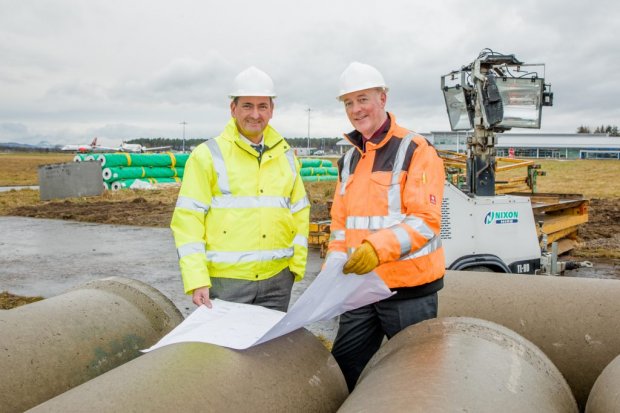Inverness Airport makes Multi-million investment in Environmental Upgrades

Inverness Airport has recently completed the first phase of a £5.5 million project to modernise the airfield’s surface water drainage system.
The original drainage pathways – which dated back to the original 1940 RAF Dalcross aerodrome – were disconnected, due to concerns contaminated water could enter and damage the local ecosystems.
Creating new drainage sections also increased the capacity for storing water on site during periods of high rainfall, reducing the overflow risk of untreated water. These new sections were sealed with impermeable liners to prevent the leaching of contaminants, and also now link additional areas to the water treatment system – including airfield taxiways and aircraft parking areas.
In addition, surveys were carried out in the Moray Firth to investigate the proposed route for a new discharge pipeline. This was carried out in consultation with Scottish Natural Heritage and the Scottish Environment Protection Agency, to ensure no disturbance to the many species of birds and other wildlife which inhabit this area.
The second phase of the project is due to commence in autumn 2019, and will include upgrades to the original system and the construction of a new outfall route.
Dan Mason, Airfield Operations Manager at Inverness Airport, said, “This has been a very successful start to the project, with the airport liaising closely with the local community as we wanted to make sure they knew what was happening and why. We’re looking forward to seeing the positive impacts this work will have.”
HIAL has also recently achieved the Bronze level of the Resource Efficiency Pledge from Resource Efficient Scotland. A nationwide scheme backed by the Scottish Government, Resource Efficient Scotland supports organisations to use energy, water and raw materials effectively.
To obtain the Bronze level pledge, HIAL committed to a range of aims which were demonstrated by:
- developing the 2017 Environmental Policy
- creating an Environmental Working Group to help develop policies and the Environmental Strategy
- staff training sessions in water sampling and calibration methods.
Julie Bhatti, HIAL’s Environmental Advisor, said: “Gaining the Bronze level pledge gives us the recognition that we are taking our environmental commitment seriously, as well as demonstrating our commitment to sustainable economic growth in Scotland.”
Work to achieve the Silver level Pledge will begin next year.
These are just two recent examples of HIAL’s commitment to continually improving its airports’ environmental and sustainability performance. HIAL is developing an ambitious Environmental Strategy for 2020-2030 and will strive to exceed the Scottish Government’s targets. To focus on innovative opportunities, eight environmental pillars have been established – including Waste Management, Ecology and Landscape and Energy Consumption and Carbon Management – which are based on sustainable development goals and models.


